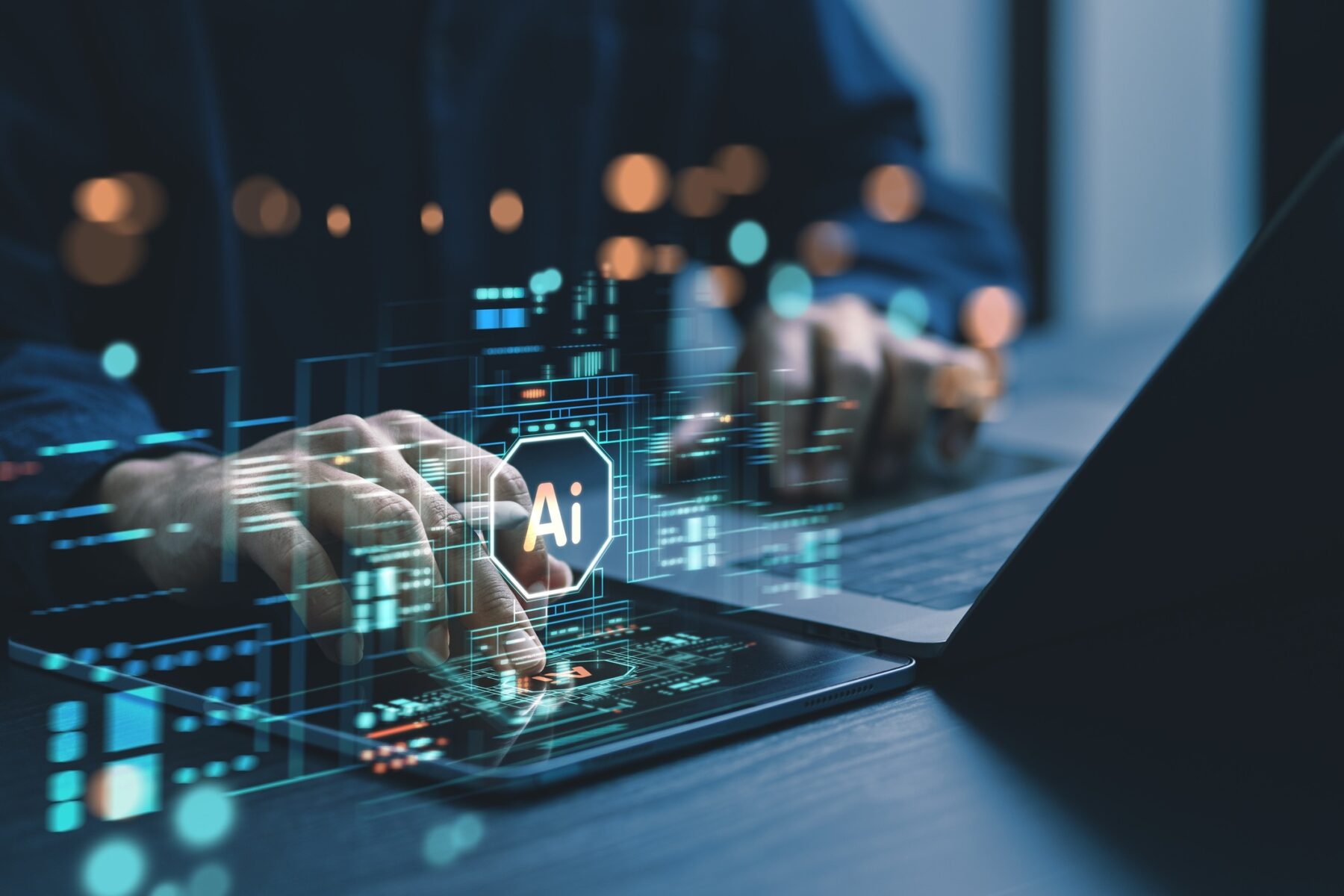- The large language models from OpenAI, Google, Anthropic, and xAI are setting the pace for performance and adoption, clearly leading the group. Meanwhile, Meta is playing catch-up after falling behind.
- The number of AI-chatbot users and spending on AI applications are rising rapidly, and autonomous AI agents are likely to accelerate this trend even further.
- Investment in AI hardware and infrastructure continues at a strong pace. New players, such as sovereign clouds¹, are adding to the capital expenditures of traditional cloud providers.
- Our global strategies remain invested in the AI megatrend. We expect the growth trajectory for semiconductor firms like Nvidia, Broadcom, TSMC, and BE Semiconductor to remain intact over the coming quarters. AI applications and agents should serve as a tailwind for cloud providers Microsoft and Amazon, as well as for Meta and SaaS companies like ServiceNow and Datadog.
- In our European strategies, our AI exposure is primarily focused on semiconductor equipment makers ASML, ASM International, and BE Semiconductor, alongside AI heavyweights SAP and Schneider Electric.
In our first paper, "Investing in AI Beyond the Hype", we outlined the various stages of AI development across the value chain (see Figure 7). We believe the growth phase for both infrastructure and applications has now begun.
Large Language Models (LLMs) were often initially written off as interchangeable commodities in a "race to the bottom". Now, however, we see the clear dominance of the "big four," whose role is starting to resemble that of operating systems. Moreover, AI spending is on the rise from both companies and consumers, with chatbots enjoying a surge in popularity. Here, we explain the drivers of this rapid growth and explore the success of ChatGPT. AI agents, the next evolution of classic chatbots, can complete entire workflows autonomously. We will show why this market's growth is just getting started and what factors point to a much larger total addressable market.
Following tariff threats from Donald Trump in early April, investors grew concerned that high levels of AI spending could be curtailed amid growing economic uncertainty. However, given the demand drivers outlined above, we continue to anticipate robust investment activity. Furthermore, new players are emerging in the form of Sovereign Clouds, creating additional growth avenues for semiconductor companies. We quantify the scale of these opportunities and identify the key players to watch over the next year. We also highlight the companies set to benefit from investments in TSMC's cutting-edge N2 technology node.
The "Big Four" and the Future of LLMs
The pace of technological development for LLMs is breathtaking, with major upgrades rolling out every three to six months. As Figure 1 shows, the race to build the most powerful AI model is in full swing. It has become a genuine head-to-head competition between Google's Gemini, OpenAI's ChatGPT, Anthropic's Claude, and the latest entrant, Elon Musk's Grok from xAI. Over the past few months, these market leaders have widened their lead over the competition. Despite its leading technology, DeepSeek will likely struggle to penetrate the Western enterprise market due to its Chinese ownership.
Meta's Llama had fallen significantly behind, prompting CEO Mark Zuckerberg to launch an aggressive catch-up campaign, complete with a talent acquisition blitz. He has already poached top researchers from OpenAI and Google DeepMind and brought Scale AI founder Alexandr Wang into the fold. At the same time, Meta secured strategic access to high-quality training data through a 49% stake in Scale AI.
Figure 1: xAI, OpenAI, Google and Anthropic top the Artificial Analysis Intelligence Index¹
We are seeing growing enterprise adoption and spending on these models, as illustrated in Figure 2. While some experts initially dismissed LLMs as interchangeable commodities in a "race to the bottom," a few dominant models are now emerging that look increasingly like operating systems. They provide core APIs, foster developer ecosystems, and offer distribution models that allow third parties to build their own "apps" on top. AI agents, which we discuss later, are a prime example. In short, control over the leading LLMs - along with the necessary compute, proprietary data, and the applications built around them - is a critical component for future technological leadership.
Figure 2: Percentage of US companies with paid subscriptions to AI models, platforms, or tools – OpenAI benefits the most
The Rapid Rise of AI Chatbots
Since OpenAI launched ChatGPT in late 2022, AI chatbots have seen explosive growth. Users have embraced them for their precise, context-aware responses. As shown in Figure 3, ChatGPT is the fastest-growing consumer app of the internet era and the clear leader in the chatbot space. Thanks to the release of the free top-tier model GPT-4o, deeper OS integration with Apple, new enterprise features, and in some cases drastic price reductions—such as 20% cheaper ChatGPT subscriptions and an 80% lower o3 API rate—OpenAI recorded its strongest growth to date in the first half of 2025.
Figure 3: ChatGPT is the fastest growing consumer application
As Figure 4 illustrates, although their traffic is still a fraction of Google Search, chatbots are quickly becoming a major force. In June 2025, ChatGPT.com ranked as one of the world's top websites, while Google.com held the top spot. AI chatbots have cemented their role as essential tools for web search, research, and productivity growth. With its powerful consumer brand, ChatGPT benefits from a strong user lock-in effect driven by personalized search dialogues.
Figure 4: AI-Chatbots displaying strong growth vs Google Search
AI Agents: The Next "Killer App"
There are strong signs that AI is entering a new stage of development. AI agents represent the next evolutionary stage of traditional chatbots. These tools can figure out goals on their own, plan several steps ahead, and take action in external software, such as running code, using APIs, or automating business tasks. Companies can use open-source tools like AutoGPT or LangChain to build their own workflows, or rely on integrated solutions like Microsoft’s Copilot, Salesforce’s Agentforce, or ServiceNow’s AI Agent. These products show how far the field has progressed in just a short time. Different solutions dominate:
- Application-specific agents, such as productivity tools for developers like Cursor AI, GitHub’s Copilot, or Devin.
- Collaboration agents embedded within SaaS platforms, including Microsoft’s Copilot, ServiceNow’s Agent, Salesforce’s AgentForce, and SAP's Joule Copilot.
- Frameworks for custom agent workflows, such as AutoGPT and LangChain.
The first measurable revenue opportunity lies in the software development segment. Globally, there are approximately 40 million developers. By 2025, the market for developer and productivity software will exceed USD 90 billion and is growing at a double-digit rate.² Code agents already generate a meaningful share of this. At major tech firms, roughly one-quarter to one-third of new code is now written by AI-supported code agents. GitHub’s Copilot and Cursor AI, for example, are generating over USD 0.5 billion in annual recurring revenue.³ Devin targets power users with pricing of up to USD 500 per month for team plans and Cursor has introduced an “Ultra” tier at USD 200 per month since June 2025 while delivering productivity gains that significantly outweigh the cost in terms of time saved and error reduction.⁴
However, Code agents are only the beginning. Agentic systems have the potential to automate complete end-to-end processes within enterprises, significantly reduce costs, and enable entirely new business models, such as autonomous customer service workflows or optimized supply chains. We believe the practical value and market potential of these solutions remain materially underestimated over the long term.
For software companies, this development is a double-edged sword. On the one hand, software development is likely to become more cost-efficient; on the other, it will intensify competitive pressures by lowering the barriers to entry. We favour software companies that are riding the wave of demand for computing power from infrastructure providers, such as cloud providers. In addition, we seek companies that offer proprietary datasets, robust distribution capabilities, and ideally, strong positioning in vertical-specific enterprise solutions.
Semiconductor Spending Shows No Signs of Slowing Down
Following Donald Trump's tariff threats in early April, investor concerns initially centered around whether the high levels of capital expenditure in artificial intelligence would continue amid rising macroeconomic uncertainty. A clearer picture has since emerged: despite persistent economic headwinds, AI investments are expected to accelerate over the coming months. This momentum is driven by the rapid adoption of already-deployed AI models and the associated exponential growth in token usage. So-called "reasoning" models, AI systems capable of complex problem-solving, planning, and agent-like execution, require 100 to 1,000 times more compute than standard chatbots. As a result, demand for high-performance chips continues to surge, while current supply still lags capacity needs.
Demand is being led by the four Big Tech players. Since the launch of ChatGPT, Microsoft, Amazon, Google, and Meta Platforms have more than doubled their total AI-related capital expenditure. Except for Microsoft, all of them have further increased their investment plans since the beginning of the year (see Figure 5). In parallel, several large-scale infrastructure projects have been announced:
- Stargate, a consortium involving OpenAI, Oracle, MGX, and SoftBank, intends to build a comprehensive AI data center network in the U.S. within four years, with projected investments of up to USD 500 billion.⁵
- Colossus, a supercluster developed by Elon Musk’s xAi, is expected to deploy up to 1 million GPUs across its infrastructure—implying total investments of USD 30–60 billion.⁶
- A growing number of AI data center operators—including CoreWeave, Lambda Labs, Nebius, and Cerebras Cloud—are ramping up semiconductor investments, alongside traditional players like Oracle repositioning themselves to offer compute capacity.⁷
It remains to be seen how many of these projects will ultimately materialize and at what scale. Nonetheless, current announcements point toward a continued surge in AI-related infrastructure demand in the years ahead.
Figure 5: Among the 2025 capital expenditure forecasts (in USD billion) for the 4 Big Tech companies, Amazon shows the strongest analyst revisions
Besides private investors, the strong demand for artificial intelligence is also attracting government actors. Just as governments once funded rail networks and other major infrastructure projects, billions are now being poured, under the banner of so-called “Sovereign AI”, into AI data centers and national data platforms that are gaining ever-greater strategic importance. Nvidia recently presented illustrative examples of this at its GTC conference in Paris. Current plans include, among others:
- The expansion of AI computing power in Europe over the next 24 months. Approximately 20 AI data centers are planned, which could increase GPU computing power on the continent by about tenfold. Large server clusters are to be installed in Germany, France, and the United Kingdom.
- Specific projects include, for example, an 18,000-GB200 system in France, a 14,000 Blackwell system by Nebius and Nscale in the United Kingdom, as well as an industrial AI cloud in Germany with about 10,000 GPUs for automobile manufacturers and robotics companies.⁸
- Outside Europe, Saudi Arabia has announced an AI investment program called “Project Transcendence,” which is expected to provide up to USD 100 billion for the development of “AI factories of the future.” The goal is to create an independent national AI ecosystem and cover large parts of the value chain from cloud and data centers to proprietary AI models.⁹
In addition to Nvidia’s high-performance GPUs, application-specific integrated circuits (ASICs), often simply called “custom silicon”, are now moving into the spotlight. Meanwhile, all major cloud providers are developing their own ASICs precisely to their customers’ requirements. For certain workloads and application scenarios, this solution is often significantly more cost-effective than using Nvidia’s high-end chips. These include:
- Google’s Tensor Processing Unit (TPU), which is primarily used for internal workloads (Google Search, YouTube, etc.). TPUs have been developed together with Broadcom since 2016 and are now in their 8th generation.
- Meta’s MTIA processor, which supports backend functionalities such as deep learning, ad selection and ranking, as well as the company’s AI tools on platforms like Instagram and Facebook.
- Other programs with Bytedance, OpenAI, and Arm. Most of these programs are still in early stages and are expected to be brought into production over the next 24 months. Broadcom expects that each of these customers will eventually build clusters with more than 1 million chips.
Overall, we expect the share of ASICs in all accelerated workloads to rise from 12% to approximately 25-35% in the coming years. In this context, Broadcom has established itself as the leading co-design partner for custom silicon. Due to strong and visible order books from major customers, the company already anticipates AI-related growth of 60% in 2026 compared to the previous year.
The developments described represent only a selection but illustrate that demand for high-performance chips now stands on much broader footing. Due to rising demand from cloud providers, government contracts, and large enterprises, Nvidia as market leader now sees a pipeline of around USD 1.5 trillion in total AI investments, indicating further growth for the coming years.¹⁰
Figure 6 brings these developments together. From 2022 to 2024, growth in AI investments was still primarily driven by the four major “Big Tech” providers (Amazon, Microsoft, Google, Meta Platforms). Over the coming years, however, Tier 2 cloud providers, government projects, enterprise applications, and custom silicon will play an increasingly central role. This leads to a growing divergence in the expected spending trends, which the figure illustrates.
Although risks remain regarding cyclical factors, rapid model innovations, and export restrictions, most data points indicate continued strong growth in AI investments this year and next. The global expansion of data centers also benefits traditional industrial companies such as Schneider Electric. As one of the world’s leading providers of highly efficient energy, cooling, and UPS systems, Schneider could profit from the rising demand in this market.
Figure 6: Growth in AI investments is increasingly driven by new players – in bn USD
Semiconductor Equipment Suppliers Benefit from TSMC’s New Technology Node Introduction
The persistently strong demand for AI chips and the next generation of smartphones are driving production growth at TSMC. The contract manufacturer is de facto the sole supplier of high-end AI chips for companies like Nvidia, AMD, Broadcom, and others, benefiting from delays at Intel, which will likely postpone its entry into leading AI chip manufacturing until 2027/28. Until then, this results in a quasi-monopolistic position for the company in the production of next-generation high-performance chips.
TSMC’s new 2-nanometer technology node (N2) is expected to enter mass production by the end of this year. High utilization is likely to further boost the investment willingness of semiconductor equipment suppliers ASML, ASM International (ASMI), and BE Semiconductor Industries (Besi); all three hold dominant market positions in their segments:
- ASML holds a monopoly in lithography. The transition to N2 requires additional extreme ultraviolet (EUV) systems of the latest generation.
- ASMI is a leader in atomic layer deposition (ALD) systems. ALD is a key technology for the gate-all-around (GAA) transistor architecture, which enables lower power consumption, higher performance, and reduced heat generation.
- Besi dominates the market for hybrid bonding equipment. This technology connects different chip components in three-dimensional stacks, providing performance, efficiency, and cost advantages for increasingly large and complex AI chips.
Overall, the closely linked technological advances at TSMC and the equipment oligopolies of ASML, ASMI, and Besi are expected to mutually reinforce each other at least until 2027/28.
Conclusion: Growth and monetization of AI are gaining momentum. Chip Investments enter the next phase.
We see clear signals that the next phase of the AI cycle has already begun. In our first paper, “Investing in AI Beyond the Hype,” we used the stock price development of mobile internet as a benchmark (see Figure 7). While 2023 and 2024 saw mainly chatbots and applications with limited intelligence enter the market, advances in training and inference of large language models now lead to significant leaps in quality and speed. This has triggered explosive growth in both chatbot user numbers and corporate adoption of AI applications. This increased demand for computing power, in turn, drives strong investments in semiconductors.
Against this backdrop, we remain constructive on the AI sector: Nvidia remains the undisputed number one in GPUs, while Broadcom dominates the market for custom chips (“custom silicon”). The manufacturing of such components is currently possible only with the factories and expertise of TSMC. Semiconductor equipment suppliers ASML, ASMI, and Besi benefit from investments in TSMC’s N2 technology node, which will enter mass production at the end of this year.
On the application side, ChatGPT has established itself as the clear leading chatbot with over 800 million monthly active users. The strongest growth acceleration is seen among LLM providers OpenAI and Anthropic. Through Microsoft, we are indirectly invested in OpenAI and through Amazon, we are indirectly invested in Anthropic in our global equity strategies. Microsoft benefits from its cloud partnership with OpenAI, and a significant portion of Anthropic’s computing workload is handled via AWS. All cloud providers should also benefit from rising demand for computing power for AI applications and AI agents. SAP holds a very strong position in the data layer of large enterprises and expects accelerated growth because companies must increasingly migrate their ERP systems (Enterprise Resource Planning System) to the cloud in the AI era. The global expansion of data centers fuels Schneider Electric’s business, which, as a leading provider of highly efficient energy and cooling systems, could directly benefit from the rising demand.
For software companies, AI represents both an opportunity and a risk, as it lowers entry barriers for new competitors. Datadog is likely to benefit from cloud providers’ growth thanks to new products and AI use cases. We believe ServiceNow will remain a leader in AI-powered workflow and productivity solutions.
Figure 7: Monetization cycle in the mobile age
Authors

Martin Hermann
Martin Hermann has been a Portfolio Manager at Berenberg since October 2017. He is responsible for the Berenberg Global Focus Fund and the global wealth management strategy “Equity Growth”, and serves as co-portfolio manager of the Berenberg European Focus Fund. Prior to joining Berenberg, he was a Portfolio Manager within Allianz Global Investors’ award-winning Europe Equity Growth Team and deputy portfolio manager of the International Equity Growth Fund. He began his career in 2010 as an investment trainee in the Graduate Programme at Allianz Global Investors. Martin Hermann holds a Master’s degree in Investment Analysis and Corporate Finance from the University of Vienna and is a CFA charterholder.

Tim Gottschalk
Tim Gottschalk has been a Portfolio Manager at Berenberg since January 2022. He started his career in the Berenberg International Graduate Program with assignments in Asset Management, Wealth Management and Equity Research. Tim Gottschalk holds a Bachelor of Science in Business Administration and a Master of Science in Finance with Distinction from the University of Cologne with stays abroad in Dublin and Stockholm.



